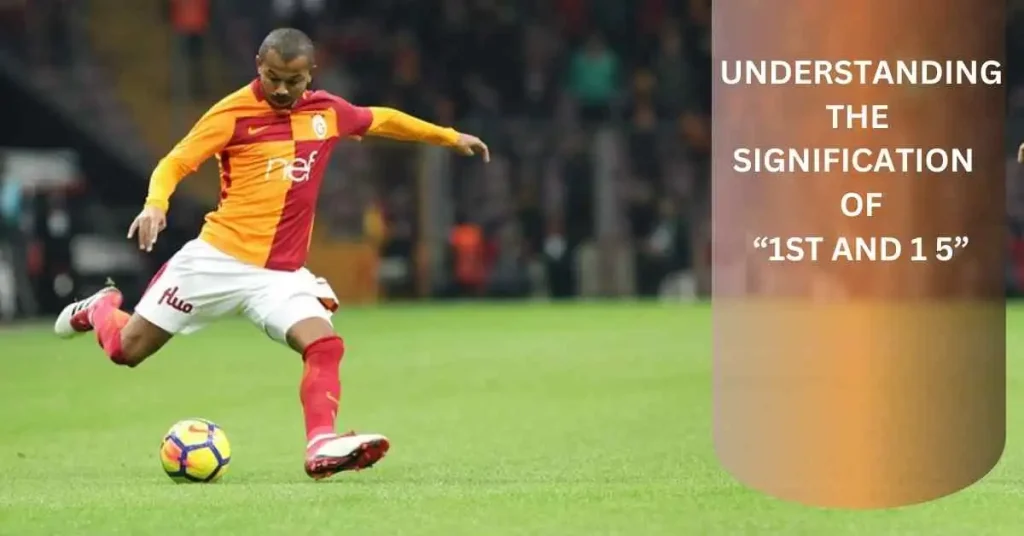
For newcomers to football, the terminology and phrases thrown around during a game can be a bit jargon-y, none more so than the terms surrounding the down and distance system. One phrase you often hear during a football game is “1st and 15″. Whether you are attending this game with friends or just looking to learn the language better, knowing the meaning of “1st and 15” can help you enjoy the sport more.
We’ll tell you what 1st and 15 in football are, break them down into similar terms, such as 1st and 10, and explain how football teams use the terminology. We’ll also cover what is 1st down in football and other terms you need to know, such as 2nd and five and 4th and 1, so you don’t get lost next time you’re watching a game.
What Does 1st and 15 Mean in Football?
When the term “1st and 15” is used during a football game, it represents a down and distance that the offensive team must run to get a first down. In this example, the team that has been on the offensive has a first down (the “1st”) and has 15 yards to gain another first down (the “15”).
When a team controls the ball, it has four tries to move it 10 yards, called “downs.” The team attempting the fourth down is given a chance to win or lose another first down; if they win, they are given a first down. If it doesn’t make at least 10 yards in those four tries, it must either give the ball up to the other team or try a field goal or a punt, depending on the circumstances.
A first and 15 is usually the result of a penalty on the offensive team’s part (such as illegal movement, which forces the offense 5 yards back from the line to gain/stick and is often five or ten yards from the original line of scrimmage).
What is 1st Down in Football?
What is a 1st down? A first down is when the offensive team begins a new series of plays to move the ball at least 10 yards. It is the term for the first of the four attempts to make that 10-yard distance.
Should the team make the 10-plus yards on the second or third attempt, they receive another first down and thereby have the opportunity to reset their downs (continue the drive). Put simply, the first down is what keeps the offense moving.
What does 1st and 10 mean in football?
1st and 10 refers to the situation of the offensive team, which is awarded a first down and then must cover 10 yards to reset the downs. It is the spot where the offensive possession begins. This is important in football, as it establishes what you will do during a drive and your team’s goals for those first four tries.
What is 1st and 10 Meaning? The offensive team begins their drive on first down and must move the ball at least 10 yards for a new set of downs. The defence must try to stop them by tackling the ball carrier or creating a turnover. The ball is placed at the 25-yard line following a kickoff or at the spot where a play ended. The team has four tries, called downs, to get those 10 yards and start the process over. They make another first down if they make the 10 yards on the first or second attempt. This is the process that repeats throughout the game.
What Does 1st and Goal Mean in Football?
So now, let’s move forward and talk about what “first and goal” means in football. This comes into play when the offensive team is in the red zone or with a first-and-goal on the 8-10 yard line, for instance. The word “goal” means the goal line, so when a team faces first and goal, it is attempting to score a touchdown.
In this case, the offensive team may have four attempts to advance the ball up the field and reach the end zone. This is a huge situation, and the defence must do everything possible to prevent them from getting into the end zone. The offense’s objective is to take the 1st & goal and score a six-point touchdown.

What Does 2nd and 5 Mean in Football?
2nd and 5 means the team received 5 yards on 1st down, and now they have five more to go to achieve a first down. It’s an advantage for the offense because it’s a shorter distance than 1st and 10. To make up these final 5 yards, the team has four tries.
What Does 4th and 1 Mean in Football?
The fourth and one is really one of the key points in a football game. That means the team with the ball has one down left to advance the ball at least one yard to keep possession. The other team gets possession if they don’t pick up that yard. Frequently, at this stage, teams in 4th and 1 situations will simply go for a quarterback sneak a or run up in the middle to earn those 1 or 2 yards.
1st and 15 vs.1st and 10 in football?
Having gone over 1st & 10 football and similar vocabulary, you might be curious to know how 1st and 15 differ from 1st and 10. The primary difference is in the yards to first down, however. Whereas 1st and 10 signifies the offense requires 10 yards to gain enough for the first down, 1st and 15 signifies the moment a team has been penalised and now has to cover an extra 5 yards.
1st and 15 usually results after an offense commits a penalty(holding, false start), and the offensive team is pushed back 5 yards from the line of scrimmage to start the play. Now, the team has 15 yards to gain instead of the usual 10.
What is 2nd and 10 in Football?
In football, 2nd 10 would mean that the team is playing it 2nd down and needs 10 yards to make a 1st down. This can occur if they did not gain or lose a yard on the previous play. It’s effectively the 1st and 10 to start a new drive, but now the club is on its second attempt at covering 10 yards.Read more here.
Conclusion:
Whether you are a casual fan or hardcore follower, understanding terms such as 1st and 15, 1st and 10, and 4th and one will enable you to follow the flow of a game and anticipate the approach each team will take. So, now that you are up to speed, you should have some terms to get you through the next football game!
FAQ’S:
What does 1st down mean in football?
The first time a team can gain 10 yards in football is on 1st down. If they do so, they get a new set of downs, enabling them to keep moving toward the other team’s end zone.
What does 1st and 10 mean in football?
1st & 10 is shorthand in football for the team having a first down and needing to move the ball 10 yards forward to reset the downs and keep possession of the ball.
What is a 4th and 1 in football?
So 4th and 1 is when the offense is on their fourth down, but needs to move 1 yard forward to get the ball back. Failure to pick up one yard will result in a turnover on downs to the other team.
What is 2nd and 5 in football?
2nd and 5 implies that the team already reached 5 yards on the first down, and they have their second chance to get at least 5 yards again to reset the down.
What is the 1st and the Goal in football?
1st and Goal is one play away from a touchdown. The team has four plays to get to the goal line.
What does 2nd and 10 meaning in football?
2nd and 10 is when the team is on its second down and needs 10 yards to get a first down.
What does 1st and 10 mean in football?
What is 1st & 10 in football? It just denotes where a team’s offensive possession began. They are 10 yards away from the first down and the continuation of this drive.
